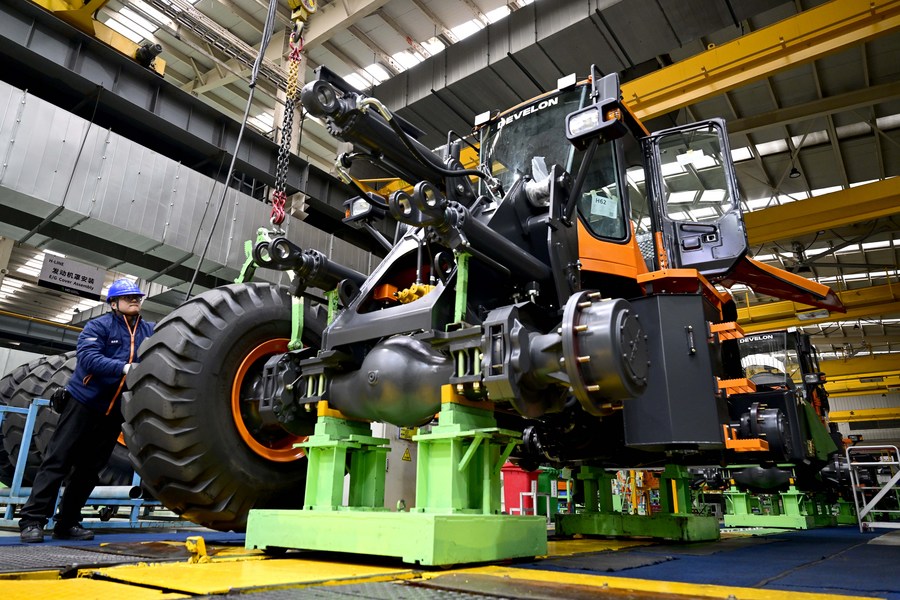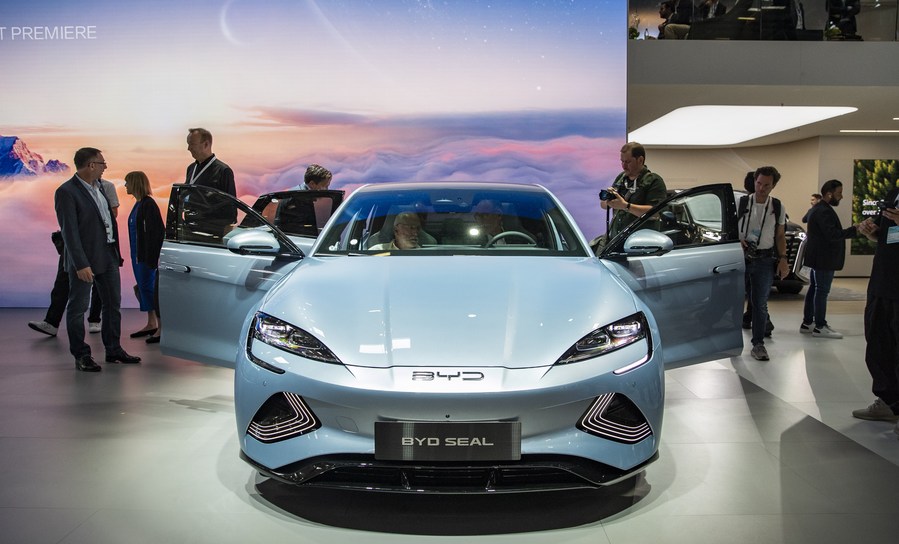
An employee works at a wheel loader assembly line of a Develon subsidiary in Yantai, east China's Shandong Province, Dec. 26, 2023. (Xinhua/Guo Xulei)
BEIJING, Jan. 17 (Xinhua) -- China's manufacturing sector began the new year with a lot of reasons to celebrate. Full-year data from 2023 showed that auto production and sales both hit a record high to top 30 million units each; exports of solar batteries, lithium-ion batteries and electric vehicles exceeded the 1-trillion-yuan mark for the first time; and the sector's exports scale maintained the world's No.1 position.
Earlier this month, the nation's domestically-built large cruise ship, the Adora Magic City, completed its maiden commercial voyage, while the domestically produced C919 large passenger aircraft commenced regular commercial flights via the Beijing-Shanghai route. In overseas markets, Chinese-made light rail trains were launched in Mexico City and Chinese-made laser TVs reported robust growth in Europe.
The enormous sector, which gave rise to the term "the world's factory," has now reached a level that highlights innovation-driven development more than ever before, even if its resilience is being tested as rising protectionism, in its varied forms, threatens global trade development.

People visit the exhibition areas of TCL (L) and Hisense (R) during the 2024 Consumer Electronics Show (CES) in Las Vegas, the United States, Jan. 11, 2024. (Xinhua/Wu Xiaoling)
SHOWING GREAT RESILIENCE
Pressurized by some nations' push to decouple and sever supply chains under the pretext of security and impose trade restriction measures in the name of "de-risking," China's manufacturing industry has maintained resilience and made advancement through persistent technological innovation, continuing to provide diverse and affordable products and services to consumers around the globe.
"From a small power bank to a large green electric car, Made in China can meet the needs of different markets," said Wang Lingjun, deputy head of the General Administration of Customs, while he revealed China's annual trade data for 2023, last week. The data showed the country's total imports and exports of goods rose 0.2 percent year on year to 41.76 trillion yuan (5.87 trillion U.S. dollars). Exports alone went up 0.6 percent.
The world's second-largest economy has made this achievement amid a December forecast by the UNCTAD that predicted global trade in 2023 would contract by 4.5 percent compared to the 2022 level, with trade in goods expected to contract by nearly 7.5 percent.
Explaining China's better-than-expected trade performance, Wang said that one of the reasons is because of China's ultra-large market and the nation's strong capacity in manufacturing, adding that the competitive advantages of Chinese products were solid, and that the export momentum reflected China's growing strength in the manufacturing industry.
Fang Xueyu, president of Chinese home appliance maker Hisense Group's international marketing unit, told Xinhua that Chinese companies no longer rely solely on its supply chain cost advantage when going global. "In the past, it was more about competing on price, but now it's about the advantages of high technologies, high added value, and high quality."
Fang said that Hisense's overseas business has maintained steady growth in the past decade. Take the German market as an example, data shows that Hisense TV sales in the country increased by more than 60 percent year-on-year in the first half of 2023, with laser TVs registering even faster growth.
Global Sources, an international trade online platform, recently published an article on its website, saying that the strength of China's manufacturing industry is the result of a combination of factors, including a large and cost-effective labor force, robust infrastructure, supportive government policies, technological advancements, and access to a vast consumer market.
It said that China's technological advancements are also key to its manufacturing prowess. "Over the years, China has made significant investments in research and development, fostering innovation and the adoption of advanced manufacturing technologies. This includes automation, robotics, and artificial intelligence, which have greatly increased productivity and quality control in Chinese factories."
"China's manufacturing industry remains a key driver of its economy and a major player in the global market," it said.

This photo taken on Sept. 4, 2023 shows a BYD Seal electric car during the press preview of the 2023 International Motor Show (IAA) in Munich, Germany. (Xinhua/Zhang Fan)
AIMING FOR HIGHER GROUND
Early this month, news of China's BYD becoming the world's leading seller of pure electric vehicles in the fourth quarter of 2023 made headlines, with media reports describing it as a landmark moment in China's fast-growing new energy vehicle (NEV) sector. The Shenzhen-based auto company sold 526,409 all-electric cars between October and December last year, surpassing Tesla's 484,507 in the same period.
Cui Dongshu, secretary general of the China Passenger Car Association, said that after a long period of "accumulation," China's automobile exports have reached a stage of exponential growth. For instance, in the Yangtze River Delta, also a major automobile production base in China, an NEV rolls off the production lines every 10 seconds.
The inflow of skilled and knowledgeable workforce into the manufacturing field is pivotal to the sector's future development on a higher ground. A report issued in October by Chinese job-seeking service provider Liepin said that advanced manufacturing is increasingly becoming a popular career choice for China's young people.
The report, by analyzing the changes in young graduates' job applications over the past three years, said that machinery manufacturing sector has witnessed the fastest rise in terms of job application growth, followed by Electronics/Communications/Semiconductors.
In contrast, rich countries are likely to continue to lose manufacturing jobs, with the sector falling from 11.4 percent to 8.3 of the high-income workforce by 2050, the AFP reported in October, citing a think tank study.
China's Central Economic Work Conference in December last year stressed that technological innovation will be promoted to support the development of a modern industrial system. "We will promote industrial innovation through technological innovation, especially by using ground-breaking and cutting-edge technologies to foster new industries, new models and growth drivers, and develop new productive forces."
The conference also vowed fiscal and monetary policy support for the manufacturing sector by implementing structural tax cuts and fee reductions with a focus on supporting technological innovation and the development of the manufacturing industry, and guiding financial institutions to increase support for technological innovation, green transformation, small and micro enterprises, and the digital economy.
As Made in China stands on solid footing in meeting global demand, global investors are also welcome to invest in the development of China's manufacturing industry. In October last year, China announced the complete lifting of restrictions on foreign investment access in the manufacturing sector.
Jin Zhuanglong, minister of industry and information technology, said recently that accelerating the digital transformation of the manufacturing industry should be regarded as a strategic measure to promote China's high-quality development, adding that the ministry seeks to strengthen system planning and top-level design and focus on intelligent manufacturing.
China seeks to transform the manufacturing sector by boosting its quality, efficiency and power by using digital infrastructure such as 5G and the industrial internet, Jin said.




 A single purchase
A single purchase









